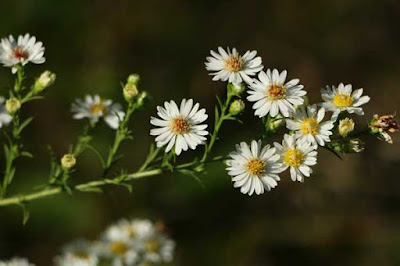Tuesday, September 26, 2017
Asters
It is officially Fall, the autumn equinox was last Friday, Sept. 22. Here in New England Asters are the native wild flower of fall. They are mostly white flowers with yellow centers, though there are some pink, violet, lavender or purple ones also. They bloom in the woods in the shade, and also in the open fields in the sun.
The photos today are of various Asters I have photographed in recent weeks. Identifying an aster isn't always easy, there are 100's of varieties world wide and about 40 here in New England.
I am not sure if the flowers above are Flat Topped White Aster or Toothed White Topped Aster, I didn't photograph the leaves which would tell me, though I know I photographed the flowers at Nasketucket Bay State Reservation in Mattapoisett, MA. on Sept. 1, 2017
Also photographed at Nasketucket Bay was this Whorled Wood Aster. I lucked out with a splash of sunlight to illuminate this plant as it was growing beside the path in the woods.
I think the above photo is of Calico or Starved Aster flowers, I photographed this in the power line cut at Ames Nowell State Park, Sept. 21, 2017. In this instance the flowers were a pale lilac, quite pretty.
I believe the flowers above are from a Small White Aster, though there is at least one other species that is possible. I suppose I should be taking one of my field guides with me on my walks, but I hate carrying the extra weight. Photographed at Great Blue Hill, in the Blue Hills Reservation Sept. 23, 2017.
These next two photos are both of New England Asters, our largest and showiest of the Native Asters that bloom in the fall. They can have a fairly wide color range from pink to a dark purple. These were photographed at Forge Pond, Hanover, MA. Sept. 24, 2017.
The yellow in the above photo is one of our many varieties of goldenrod.
I found this web site if you are interested in reading more about Asters, also the New England Wild Flower web site lists all of these species, links to their site are attached to their names above. Please note my Wild Flower guides are old, recent genetic information has caused the Asters to be reclassified (Latin names) and NE Wild Flower Society uses some different common names. If you garden some of these asters have been developed as garden plants, usually easy to grow, it is nice to have some flowers that wait until fall to bloom.
I thought I would end this post with a Dragonfly photo, this is one of the Autumn Meadow Hawk dragonflies, which one I am not sure, I am told that to make a correct ID the dragonfly needs to be examined under a microscope. Since I never capture what I photograph I have to be satisfied with just a general ID. Still I think it is a pretty picture. I can tell you that this is a male, males are red, females yellow, and it is one of the white faced species.
That is it for today, per usual comments are welcome.
Subscribe to:
Post Comments (Atom)








No comments:
Post a Comment